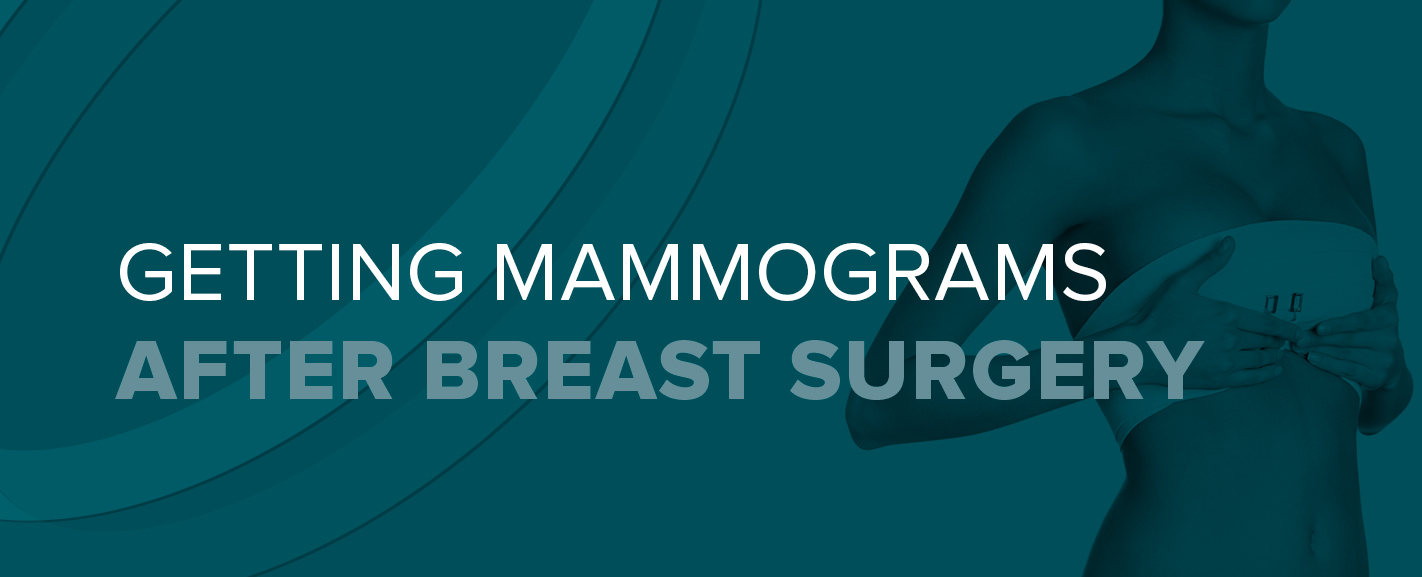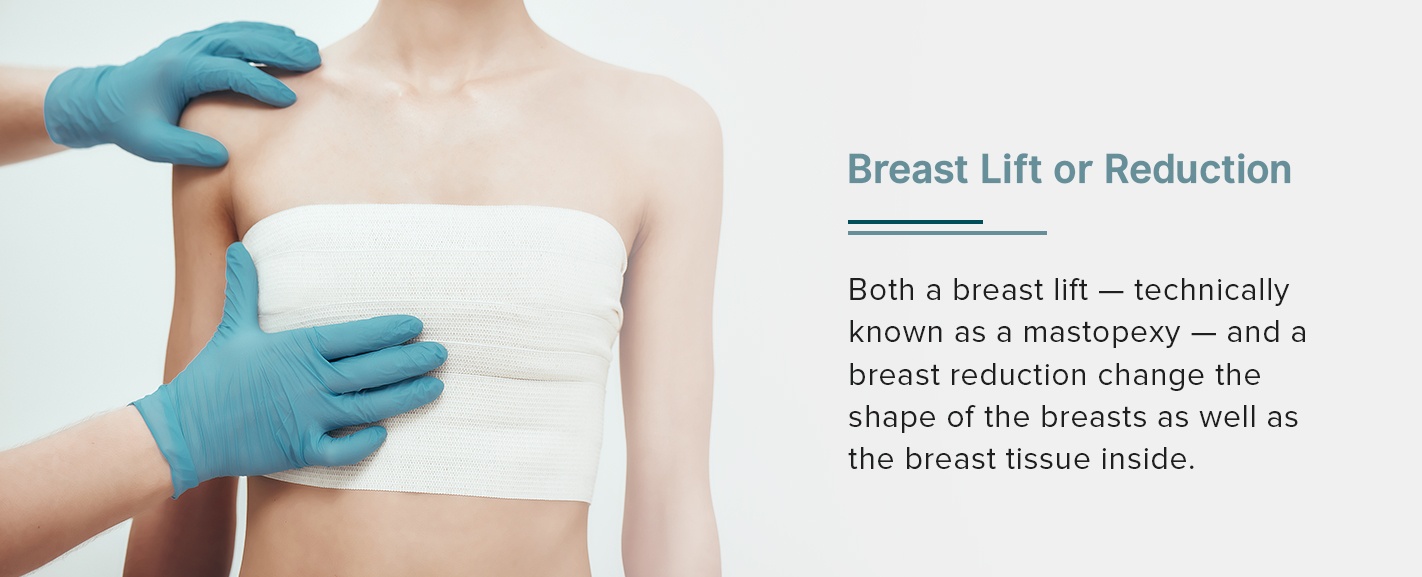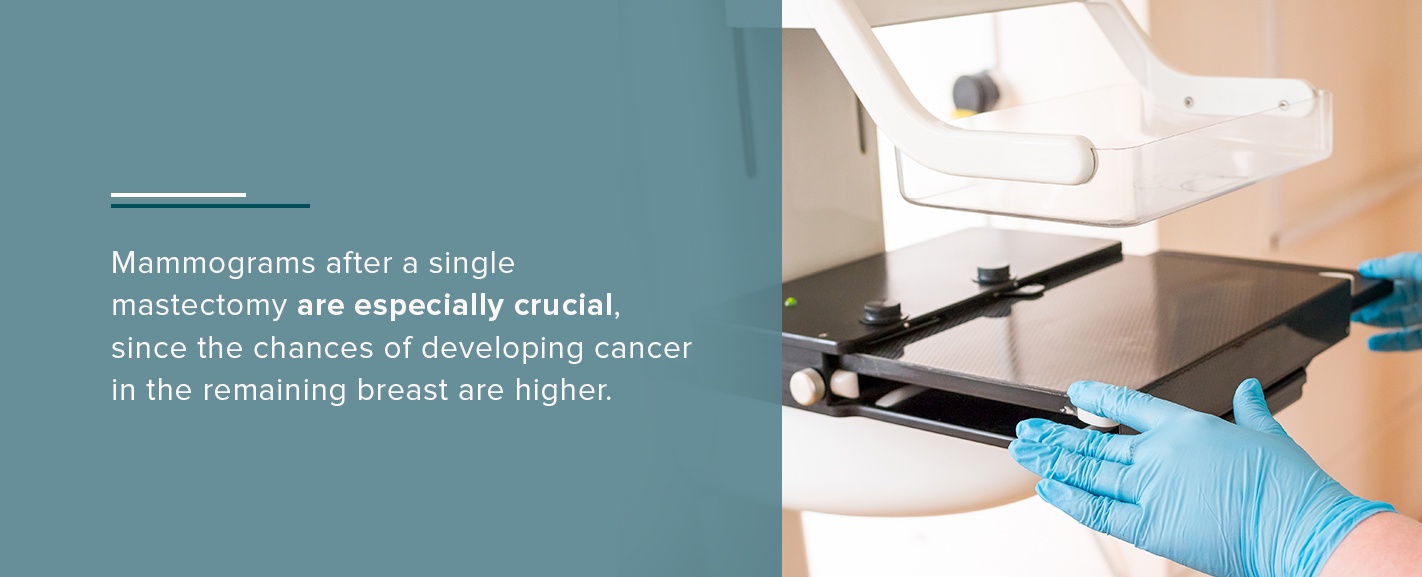Getting Mammograms After Breast Surgery

Mammograms are one of the best ways to detect cancer early, which is when it is the easiest to treat and provides the most successful results. Health professionals recommend routine mammograms for women aged 40 and over — women aged 30 and over if there is a history of breast cancer in the family.
Since radiologists examine the breast tissue for cancerous cells, people who have had breast surgery may wonder if they still need to get regular mammograms. The short answer is: Yes.
Are Routine Mammograms Necessary After Breast Surgery?
As long as there is breast tissue present, there is a risk of breast cancer. Most breast surgeries do not remove the breast tissue, and that tissue may still harbor any abnormalities.
Getting mammograms after breast surgery is especially smart if you’ve had breast augmentation or a breast lift. These procedures often entail repositioning or removing the breast tissue, which changes both the internal and external image of the breast. Because of these changes, any previous mammograms become void, since the breast tissue no longer looks the same.
A mammogram after breast surgery will be necessary to get a clearer idea of what the healthy breast looks like and to create a baseline to compare all future mammograms to. In the case of double mastectomies, future mammograms may not be necessary, because this procedure removes both breasts, leaving no tissue for examination.
Generally speaking, the experience of getting a mammogram won’t change much after breast surgery. It will still consist of the same examination with the technologist taking two images of each breast. Specific breast surgeries, like having breast implants, for example, may require more imaging or further testing to better see the breast tissue.
Mammograms After Different Breast Surgeries
The reasons for breast surgeries vary from cosmetic to health concerns, but the bottom line remains that mammograms after breast surgery can save lives. The changes in breast tissue, as well as potential scar tissue, will change what the breast looks like, requiring either additional tests or new tests, depending on the type of breast surgery had.
Lumpectomy
A lumpectomy — also called a breast-saving surgery — involves removing a cancerous lump or tumor, along with some healthy cells. After a lumpectomy, there is usually still more radiation to complete before the patient can enter remission. Radiation from chemotherapy can change the skin as well as the breast tissue, so a new baseline mammogram will be necessary after treatment.
About six months to a year after treatments, the patient can begin getting regular mammograms again, with the baseline mammogram being the one against which her health care providers will compare all future mammograms.
Sometimes, to even out the shape of the breasts, people elect to have implants or a breast reduction, both of which are procedures that still require routine mammograms going forward. “Routine” can be every year or even every six months, depending on what plan your doctor thinks is best for you.
Breast Lift or Reduction

Both a breast lift — technically known as a mastopexy — and a breast reduction change the shape of the breasts as well as the breast tissue inside. In either case, the doctor may request two mammograms: one before and one after. The one after is crucial, since it will act as the baseline mammogram — the new standard by which the health care team will measure all future mammograms.
The baseline mammogram after breast reduction or mastopexy will occur approximately six months after the procedure. However, studies have revealed it may be harder to detect cancerous cells after a breast reduction, suggesting that further imaging may be necessary. Mammograms alone after a breast lift, on the other hand, should be sufficient for breast cancer screening.
Breast Implants
Contrary to popular belief, mammograms are still an essential screening tool, even with breast implants. There will be a slight difference in the process to test for cancer without rupturing the implants.
The main issue with mammograms after breast implants is that the silicone or saline used in most breast implants make it difficult to examine the breast tissue underneath. If the implants sit atop the pectoral muscle, this process is a little easier. Otherwise, the procedure requires a technologist with experience in testing on breast implants.
The technologist will need to shift the implant so the breast tissue is more visible, and they will need to know how much compression to use, since it will be less than the amount used for natural breasts. Additional images will also be necessary to get the clearest images, but even despite all that, the doctor may require more imaging, such as an MRI or an ultrasound.
Mastectomy

Depending on the type of mastectomy you have, you may not need routine mammograms afterward. A mastectomy is the complete removal of the breast and its tissue, and since a mammogram is an examination of breast tissue, it becomes redundant if no such tissue exists, such as in a double mastectomy.
A single mastectomy is the complete removal of only one breast, which means the other breast remains intact, tissue and all, and will need regular mammograms. Similarly, a nipple-sparing mastectomy leaves some breast tissue behind, which needs to undergo regular testing.
Mammograms after a mastectomy mostly apply only to a single mastectomy or a nipple-sparing mastectomy.
A mammogram after a mastectomy is necessary on the remaining breast, where breast tissue remains. Mammograms after a single mastectomy are especially crucial, since the chances of developing cancer in the remaining breast are higher.
In a nipple-sparing mastectomy — technically known as a subcutaneous mastectomy — the surgeon leaves the nipple and a bit of the tissue behind it intact. Enough of the breast tissue remains that routine mammograms are a smart routine procedure.
Breast Reconstruction
If you’ve opted for breast reconstruction after a mastectomy, there’s a good chance you won’t need routine mammograms — as long as there is no breast tissue left to examine.
Just like if you’ve had a double mastectomy and then gotten silicone implants, your original surgery will have removed your breast tissue, so further mammograms won’t be necessary. But if you’ve only had a single mastectomy and gotten a silicone implant on that side while the other side remains unaltered, you’ll need routine mammograms on the side with natural breast tissue.
Sometimes, surgeons can complete a breast reconstruction using tissue from another part of your body, in which case routine mammograms may not be necessary if no breast tissue remains. However, sometimes your doctor might recommend a mammogram or other image testing for several reasons, including having a high risk of reoccurrence or if there is a questionable abnormality.
Schedule Your Next Mammogram
If you’re due for a routine mammogram or need to get a baseline mammogram after breast surgery, Envision Imaging is here to help. Our team of trained technologists aims to provide first-class diagnostic services and excellent patient care.
At our multiple locations all across the U.S., you can receive quality care from learned professionals without sacrificing ease. Get in touch with us at Women’s Center at Colorado Springs Imaging, or at any of the other Envision Imaging locations, to schedule your mammogram.
Call To Schedule Your Appointment
Sources:
- https://www.breastcancer.org/symptoms/testing/types/mammograms/after_surgery
- https://www.ncbi.nlm.nih.gov/pubmed/24000038
- https://www.cancer.org/cancer/breast-cancer/screening-tests-and-early-detection/mammograms/mammograms-for-women-with-breast-implants.html
- https://www.envrad.com/location/the-womens-center-at-colorado-springs-imaging/
- https://www.envrad.com/locations/


